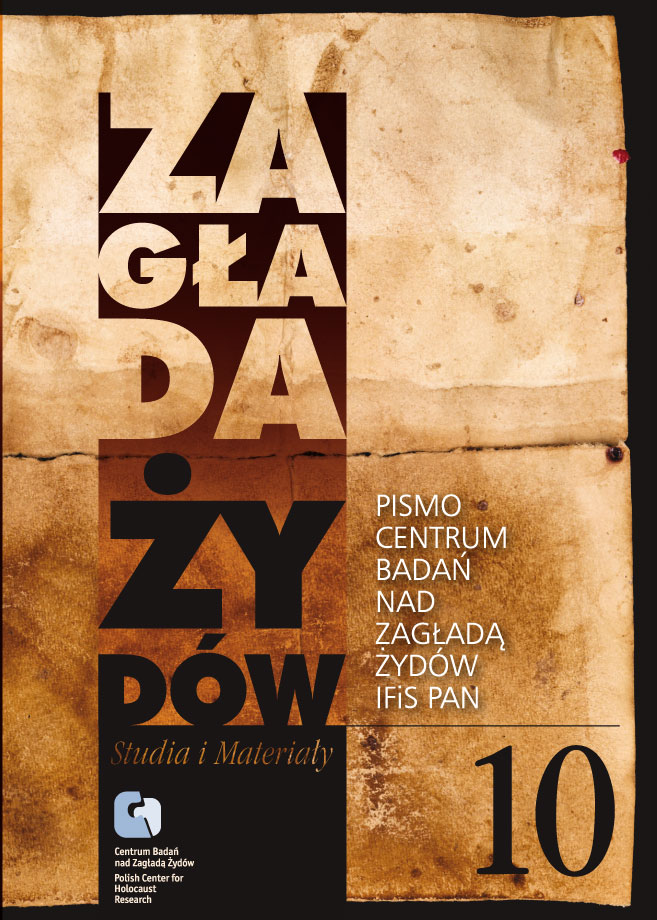Józef Kermisz (1907–2005) – twórca badań nad Szoa
Zagłada Żydów. Studia i Materiały, Nr 10 (2014), Strony: 304-316
Data zgłoszenia: 2020-10-22Data publikacji: 2014-12-01
 https://doi.org/10.32927/ZZSiM.526
https://doi.org/10.32927/ZZSiM.526
Abstrakt
Józef Kermisz (1907–2005) was a historian and an archivist who helped lay the foundations for Shoah research in Poland and Israel. In 1944 joined the Central Jewish Historical Commission where became the chief archivist. Since then his life has been devoted to retrieving wartime archival material. As archive director (in the Jewish Historical Institute in Poland and at Yad Vashem in Israel) he sought to develop an archive both for future historical research and for trials of suspected war criminal. He played a major role in discovering and preserving important documentation on the Shoah in Poland. Among his major professional achievements were preparing documentation for the prosecution in the Eichmann trial, and publishing Czerniakow’s diary and the full edition of the underground press of the Warsaw ghetto. He was one of the world’s leading experts on the Ringelblum Archive and other hidden Jewish documentation from the Holocaust. Kermisz left behind a legacy of a vast research infrastructure that he created and that will occupy scholars for generations.
Licencja
Prawa autorskie (c) 2014 Autor & "Zagłada Żydów. Studia i Materiały"

Utwór dostępny jest na licencji Creative Commons Uznanie autorstwa 4.0 Międzynarodowe.
https://creativecommons.org/licenses/by/4.0
Inne teksty tego samego autora
- Avner Shalev, Dan Michman, David Silberklang, Ścisła pamięć o Zagładzie w Muzeum Historii Holokaustu w Yad Vashem. Odpowiedź na artykuł Amosa Goldberga , Zagłada Żydów. Studia i Materiały: Nr 7 (2011)
Podobne artykuły
- Roma Sendyka, „Zbadane, ujawnione i wyjaśnione”: o metodzie śledczej w badaniach fotografii Holokaustu: Wendy Lower, The Ravine: A Family, a Photograph, a Holocaust Massacre Revealed [Roma Sendyka] , Zagłada Żydów. Studia i Materiały: Nr 17 (2021)
- Adriana Bryk, „Najlepsze dziecko Prezesa” – poczta w getcie łódzkim (1939–1944) , Zagłada Żydów. Studia i Materiały: Nr 16 (2020)
- Adam Sitarek, Dziennik Viktora Hahna z łódzkiego getta [oprac. Adam Sitarek] , Zagłada Żydów. Studia i Materiały: Nr 16 (2020)
- Michał Trębacz, „Cieszę się, że Państwo Putersznyt przeżyli wojnę i są ze sobą szczęśliwi”. Ryszard Lerczyński – jedyny łódzki Sprawiedliwy , Zagłada Żydów. Studia i Materiały: Nr 16 (2020)
- Ján Hlavinka, Historiografia słowacka wobec problematyki Zagłady , Zagłada Żydów. Studia i Materiały: Nr 11 (2015)
- Justyna Kowalska-Leder, Trzy modele zaufania wobec nie-Żydów po aryjskiej stronie , Zagłada Żydów. Studia i Materiały: Nr 20 (2024)
- Redakcja, Od Redakcji , Zagłada Żydów. Studia i Materiały: Nr 14 (2018)
- Tadeusz Bartoś, Zapomnieć , Zagłada Żydów. Studia i Materiały: Nr 11 (2015)
- Johannes Breit, Lukas Meissel, Igraszki z symboliką Zagłady. Seria gier komputerowych „Wolfenstein” jako studium przypadku cyfrowych reprezentacji Zagłady , Zagłada Żydów. Studia i Materiały: Nr 17 (2021)
- Tomasz Łysak, Yolocaust: kapitalizm platform a cyfrowe praktyki upamiętniania Zagłady , Zagłada Żydów. Studia i Materiały: Nr 17 (2021)
<< < 20 21 22 23 24 25 26 27 28 29 30 31 32 33 34 35 36 37 38 39 40 41 42 43 44 45 46 47 48 49 50 51 52 53 54 55 56 57 58 59 60 61 62 63 64 65 66 67 68 69 > >>
Możesz również Rozpocznij zaawansowane wyszukiwanie podobieństw dla tego artykułu.
 English
English
 Język Polski
Język Polski








